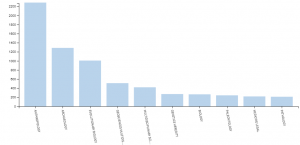Wood, J. W., Milner, G. R., Harpending, H. C., Weiss, K. M., Cohen, M. N., Eisenberg, L. E., … & Katzenberg, M. A. (1992). The osteological paradox: problems of inferring prehistoric health from skeletal samples [and comments and reply]. Current anthropology, 33(4), 343-370.
1a. Total number of citations? 8,226 (Excluding self-citations)
1b. What can you learn about the number of citations to this article per year since it was published?
The paper was relatively well cited until the year 2000 where the number of citations began to steadily increase each year indicating that the article may be part of the core literature of a field. Alternatively, it could also be reflective of the general trends in academia like the increasing number of scholars within academic disciplines or the increasing number of publications produced by authors, both of which have increased dramatically in this digital age.
1c. What can you learn about who cited this article? What are their disciplinary identifications?
Of the 5,167 citing articles the majority were categorized under anthropology or a related subfield. Interestingly paleopathology, the field from which the paper originated, is not listed as a category in this report.

2a. Total number of publications? 225
2b. What is the H-Index? 38
2c. Average citations per item? 20.08
2d. Which of these numbers would you prefer to have used in evaluations for hiring and tenure? Why?
You would have to consider whom you are comparing for hiring and tenure, an individual just coming out of a postdoc may have a low scores for all of these numbers due to the newness of their publications. The paper I chose is part of the foundational literature for a field but was cited fewer than 10 times per year in its first couple years after publication. An average number of publications per year would at least measure some form of consistent productivity but these are all poor measures for hiring and tenure unless your goal is departmental prestige.
2e. Is this kind of analysis appropriate for all academic fields? Why or Why not?
From my first answer I obviously have some issues with these measures. This style disproportionately benefits students who are in a lab-project based program where a lead professor gives students smaller research projects to work and publish on as contributions to an overall larger project, ensuring early publication and continued citations as long as people are still publishing on the head PI’s project. These measures hurt people coming from small programs who don’t have large research projects, people coming from academic fields with independently lead (and often slow) research, and people whose research requires long periods of data collection in the field which is often slowed down by politics and bureaucracy (see ecology, etc.).